Tharp's Thoughts Weekly Newsletter
-
Article: December 2014 Market Update:
Bull Normal Market
by Van K. Tharp, Ph.D.
-
Workshops: Discounts Expire Next Week on January Workshops (Held Only Once Each Year in the U.S.)
-
Tip: December 2014 SQN ® Report, By Van Tharp
$700 Discounts Expire Next Week
In a few weeks, we will be presenting two of our Foundation Workshops. Van calls these "Foundation" workshops because they provide essential material that you must master to become a great trader.
Many of the seats in these workshops are already spoken for by Super Traders, but we still have open seats at the discount.
The Blueprint for Trading Success workshop is a complete structured program that will launch you into a more advanced skill level in your trading. You’ll learn seventeen focused, strategic steps that will help you create the kind of trading results you want. We regularly hear from students that they know planning is important but they’re not sure where to start and in some cases, they don’t even know what a trading business plan should look like. Hint – it should not look like a “typical“ business plan. You’ll leave this workshop with a template in hand to guide your trading business’s development and your personal growth as a trader.
In the How to Develop a Winning Trading System workshop, we'll teach you one of the real secrets of long-term trading success — how to design or modify trading systems so they fit your beliefs, personality, and resources. Learn all of the building blocks and processes for putting them together into robust systems that can trade stocks, futures, currencies, or options. The objective is to develop a system that specifically fits you, whether you want to make 50 trades per year or 50 trades per day.
By the end of this workshop, you will be thoroughly prepared to develop systems that allow you to easily adjust to changes in the markets, or in your personal circumstances.
To register or to see our full workshop schedule, click here.
Article
December 2014 Market Update:
BULL NORMAL MARKET
by Van K. Tharp, Ph.D.
View in browser
I always say that people do not trade the markets; they trade their beliefs about the markets. In that same way, I'd like to point out that these updates reflect my beliefs. If my beliefs and your beliefs are not the same, you may not find them useful. I find the market update information useful for my trading, so I do the work each month and am happy to share that information with my readers.
However, if your beliefs are not similar to mine, then this information may not be useful to you. Thus, if you are inclined to do some sort of intellectual exercise to prove one of my beliefs wrong, simply remember that everyone can usually find lots of evidence to support their beliefs and refute others. Just simply know that I admit that these are my beliefs and that your beliefs might be different.
These monthly updates are in the first issue of Tharp's Thoughts each month. This allows us to get the closing month's data. These updates cover 1) the market type (first mentioned in the April 30, 2008 edition of Tharp's Thoughts), 2) the five week status on each of the major US stock market indices, 3) our four star inflation-deflation model plus John Williams' statistics, and 4) tracking the dollar. I will now report on the strongest and weakest areas of the overall market as a separate SQN™ Report. And that may come out twice a month if there are significant market charges.
Part I: Van Commentary—The Big Picture
We are in a period of a sideways to up market that keeps producing new all-time highs in the S&P 500 (6 new highs in December) while the 100 day range change percentage is less than 7%. To me, this is a classic sideways market that could stay the same, go up or go down. We also have a strong US dollar and deflation - gold and silver have crashed and remain in a multi-year low range. That’s the big picture in a nutshell.
U.S. Debt Clock
The State of the United States
(from usdebtclock.org) |
Month Ending |
National Debt |
Federal Tax Revenue |
Federal Spending |
Trade Deficit |
Debt Per Family |
Unfunded Liabilities |
Taxpayers |
People Supported By Them |
July 31, 2012 |
$15.93
trillion |
$2.364 trillion |
$3.632 trillion |
$810 billion |
$684,405 |
|
|
|
Dec 30, 2012 |
$16.42
trillion |
$2.452 trillion |
$3.540 trillion |
$740.7 billion |
$732,086 |
|
|
|
July 31, 2013 |
$16.89
trillion |
$2.73
trillion |
$3.535 trillion |
$703 billion |
$748,458 |
Unfunded Liabilities |
115.2 million |
109.9
95.4% |
Dec 31, 2013 |
$17.27 trillion |
$2,82 trillion |
$3,480 trillion |
$692 billion |
$751,294 |
$127.2 trillion |
115.0 million |
108.5M
94.3% |
Jan 31, 2014 |
$17.32 trillion |
$2.84 trillion |
$3.494 trillion |
$676 billion |
$752,026 |
$127.7 trillion |
115.2 million |
108.8M
94.4% |
Feb 28, 2014 |
$17.38
trillion |
$2.86 trillion |
$3.503 trillion |
$683 billion |
$752,554 |
$128.1 trillion |
115.4 million |
108.4M
93.9% |
Mar 31, 2014 |
$17.57
trillion |
$2.89 trillion |
$3.519 trillion |
$683 billion |
$758,057 |
$128.6 trillion |
115.6 million |
107.9M
93.3% |
Apr 30, 2014 |
$17.51
trillion |
$2.91 trillion |
$3.528 trillion |
$683 billion |
$758,598 |
$128.9 trillion |
115.8 million |
108.8M
94.0% |
May 31, 2014 |
$17.52
trillion |
$2.93 trillion |
$3.54 trillion |
$689 billion |
$759,341 |
$129.4 trillion |
116.0 million |
104.38M
90.0% |
Jun 30, 2014 |
$17.54 trillion |
$2.95 trillion |
$3.51 trillion |
$697 billion |
$757,392 |
$124.8 trillion |
116.1 million |
104.4M
89.9% |
Jul 31, 2014 |
$17.61 trillion |
$2.95 trillion |
$3.52 trillion |
$695 billion |
$757,358 |
$119.7 trillion |
116.3 million |
104.8 M
90.1% |
Aug 31, 2014 |
$17.70 trillion |
$2.97 trillion |
$3.53 trillion |
$706 billion |
$757,297 |
$118.0
trillion |
116.5 million |
104.5
90.0% |
Sep 30, 2014 |
$17.77 trillion |
$2.98 trillion |
$3.53 trillion |
$707 billion |
$730,321 |
$116.3
trillion |
116.7 million |
104.9
90.0% |
Oct 31, 2014 |
$17.9 trillion |
$3.05 trillion |
$3.53 trillion |
$703.5 billion |
$729,784 |
$115.4 trillion |
116.9 million |
105.1
89.9% |
Nov 29, 2014 |
$18.0 trillion |
$3.07 trillion |
$3.55 trillion |
$710.8 billion |
$729,477 |
$115.7 trillion |
117.1 million |
105.1
89.7% |
Dec 31, 2014 |
$18.04 trillion |
$3.08 trillion |
$3.57 trillion |
$713.2 billion |
$733,741 |
$92.5 trillion |
117.3 million |
104.4
89.0% |
The listing for unfunded US liabilities has continued to go down since May 31st when it was $129.4 trillion. It’s now listed at $92.5 trillion. That’s unbelievably clever manipulation - our unfunded liabilities have decreased by $36.9 trillion dollars in the last seven months. That’s an average drop of $5.27 trillion per month. Hmm, how is that done? Most of the unfunded liabilities are for Medicare and prescription drugs – for which the amounts are no longer listed on the US Debt Clock site. The Social Security unfunded liability is only a little less than our total official debt at $13.57 trillion (that’s down from $15+ trillion).
Today, our official debt is $18.4 trillion, up from $16.89 trillion in July 2013. Somehow, the government is not making that go away. So in a little over a year, our government has managed to accumulate another trillion dollars in debt. Do you have any idea how much a trillion dollars is? Let’s put that into perspective. A trillion seconds, for example, takes you back to about 30,000 BC. A stack of a trillion dollar bills would be 63,000 miles high (and that’s a regular stack of bills). If your salary is $40,000 per year, it would take you 25 million years to make a trillion dollars. And lastly, if you lived to be 80 years old, you would have to save $34 million dollars each day of your life to equal a trillion dollars. Now, you have an idea of what it means when I say our government adds a trillion dollars in new debt every 12-18 months.
Furthermore, the debt situation is so bad that the Federal Reserve has driven short term interest rates to almost zero and kept long term rates very low. Over time, this will have a fatal impact on the U.S. dollar and interest rates have nowhere to go but up. In fact, betting on eventual higher interest rates is about as close to a certain bet (long term) as you could ever make.
The US population is at 320 million with taxpayers standing at 117.33 million. The Boomer retirement wave has begun and retirees now stand at 48.1 million. The number of disabled people collecting social security stands at 11.1 million, while food stamp recipients total 46.2 million. That’s 104.4 million people that are supported by the government (or the 117.3 million taxpayers). In reality, about 11.7 million taxpayers pay 90% of U.S. taxes. This means that 11.7 million workers are supporting 104 million other people through the government. In addition, the top 1% of American tax payers pays 40% of the tax bill. Do these numbers add up to you? Do they seem sustainable? Meanwhile, the official number of unemployed is 8.97 million while the actual number of unemployed is 17.63 million. And these numbers are conservative compared with those published by Shadowstats.com which show unemployment levels at near depression level statistics.
Part II: The Current Stock Market Type Is Bull Normal
The figures below shows the percentage of days that the S&P 500 spent in each 100 day Market SQN range during 2014.
Strong Bull |
12.34% |
Bull |
52.77% |
Neutral |
31.91% |
Bear |
2.98% |
The market was in strong bull or bull 65% of the year and neutral for nearly the rest of the time. Most of the neutral days occurred from October through December.
Each month, I show a chart of the Market SQN score for 100 days but I always measure the Market SQN scores for 200, 100, 50, and 25 day. The first three of those periods are all in Bull territory and the 25 day score is Bear.
The charts below include a weekly chart of the S&P 500 over the last year, the Market SQN® score for 100 days, and the percent volatility.
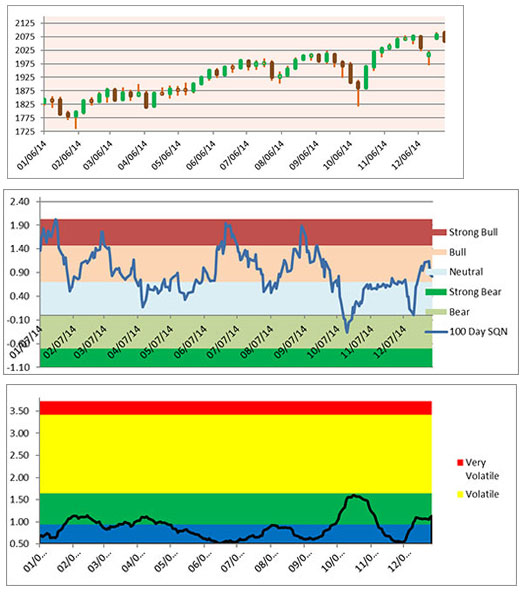
Below is a chart of the weekly changes in the three major US Indices except that I am showing just the end of year closing levels. All three indices were up for the year in 2014. The S&P 500 went up 11.35% on the year, while the NASDAQ 100 went up 17.94%. The DOW was only up 9.76% on the year.
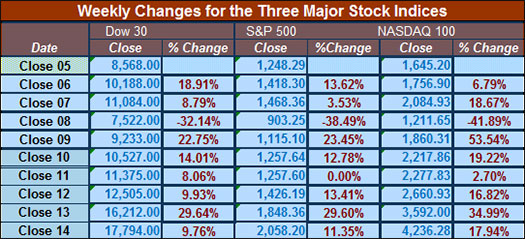
Part III: Our Four Star Inflation-Deflation Model
In the simplest terms, inflation means that stuff gets more expensive, and deflation means that stuff gets cheaper. There’s a correlation between the inflation rate and market levels, so the inflation rate can help traders understand big-picture processes.
Date |
CCI> DBC |
XLB |
Gold |
XLF |
Total Score |
Dec ‘05 |
347.89 |
30.28 |
513 |
31.67 |
|
Dec ‘06 |
394.89 |
34.84 |
635.5 |
36.74 |
|
Dec ‘07 |
476.08 |
41.7 |
833.3 |
28.9 |
|
Dec ‘08 |
352.06 |
22.74 |
865 |
12.52 |
|
Dec ‘09 |
484.42 |
32.99 |
1104.00 |
14.1 |
|
Dec ‘10 |
629.53 |
38.47 |
1410.25 |
16 |
|
Dec ‘11 |
564.37 |
33.5 |
1574.59 |
13 |
|
Dec ‘12 CCI>DBC |
556.08
27.79 |
37.54 |
1564.80 |
16.39 |
1 |
Dec ‘13 |
25.66 |
46.22 |
1674.00 |
21.86 |
1 |
Jan ‘14 |
24.88 |
44.04 |
1244.40 |
21.06 |
-1.5 |
Feb ‘14 |
26.13 |
47.08 |
1326.50 |
21.70 |
-3.0 |
Mar ‘14 |
26.12 |
47.28 |
1291.75 |
22.34 |
+0.5 |
Apr ‘14 |
26.41 |
47.67 |
1288.50 |
21.96 |
+0.0 |
May ‘14 |
26.03 |
49.08 |
1250.50 |
22.29 |
+0.0 |
June ‘14 |
26.58 |
49.64 |
1315.00 |
22.74 |
+2.0 |
Jul ‘14 |
25.32 |
48.65 |
1285.25 |
22.41 |
+1.0 |
Aug ‘14 |
25.03 |
50.53 |
1285.75 |
23.36 |
-2.0 |
Sep ‘14 |
23.22 |
49.59 |
1209.10 |
23.17 |
-2.0 |
Oct ‘14 |
22.31 |
48.40 |
1164.25 |
23.84 |
-2.5 |
Nov ‘14 |
20.42 |
49.16 |
1182.75 |
24.40 |
-2.5 |
Dec ‘14 |
18.45 |
48.59 |
1199.25 |
24.73 |
-3.0 |
We had only three inflationary months in 2014 and we have been in a strong deflationary trend for the last five months. Just look at silver, gold and commodities for confirmation.
Looking back over the most recent two-month and six-month periods provides the current month’s score given in the table below.
Month |
DBC2 |
DBC6 |
XLB2 |
XLB6 |
Gold2 |
Gold6 |
XLF2 |
XLF6 |
Total Score |
|
Lower |
Lower |
Higher |
Lower |
Higher |
Lower |
Higher |
Higher |
|
Dec 14 |
|
-1 |
|
-1/2 |
|
-1/2 |
|
-1 |
-3.0 |
Part IV: Tracking the Dollar
The U.S. Dollar continued its up-move in December. In fact, the chart below over the last 200 days is quite spectacular. The USD had a slight correction in October but by the end of the month had reached new highs again. A lot of money has been made in the dollar over the last six months. If this continues, the dollar might be worth more than the Euro fairly soon.
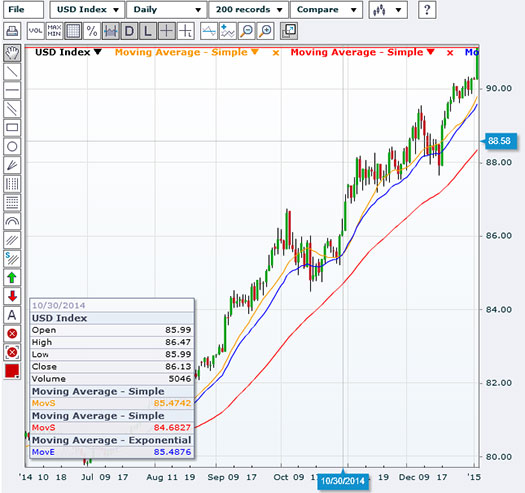
General Comments
Generally 2014 was a sideways and bullish year. The table below shows that the S&P 500 has had 48 all-time high closes during 2014. That means almost every week on average over the last year represented a new all-time high close for the S&P 500. That would seem like a spectacular year, however, it’s even more amazing that the S&P 500 was only up 11.35%. That illustrates why this year was both up and sideways - it had 48 all-time high closes while going up only moderately.
Month |
S&P 500 High Closes |
Jan |
1 |
Feb |
2 |
Mar |
3 |
Apr |
2 |
May |
6 |
Jun |
8 |
Jul |
5 |
Aug |
5 |
Sep |
2 |
Oct |
1 |
Nov |
12 |
Dec |
6 |
I have given the prescription below for the last few months.
This is my prescription for growth in the US economy. Politicians please read.
1) Kill deficit spending immediately, by stopping wars and spending on what we mistakenly call “defense.” We can’t afford to be the world peace keeper any more. We spend more than a trillion per year on “defense.”
2) Make sure no more deficit spending continues by passing a law calling for a re-election of new politicians any year the government cannot spend within their means. (I heard this first from Warren Buffet and borrowed it).
3) Right now the U.S. education system cannot compete with those of many other countries outside of the US except at the university level. And our best universities are filled with brilliant foreign students. Great, let’s accept the situation as it is and allow the brilliant foreign students who are getting masters and Ph.D. degrees to immediately become U.S. citizens instead of forcing them to return to their own countries to use the skills we taught them abroad.
4) Give a $50,000 tax rebate to any US citizen getting a Ph.D. in the United States to help them pay for their education or their education loans.
5) Allow US companies to compete in the world in a big way by eliminating the tax on the foreign earnings of US citizens living abroad. Taxing foreign earnings of US citizens living in the US are fine, but not those who must live abroad to help our corporations grow and who must also pay foreign tax on their earnings. In addition, the new tax laws requiring foreign banks to report on the assets of US citizens is totally killing our ability to compete overseas. A US company abroad is now required to have almost 100% foreign employees because US employees cannot get bank accounts that are necessary to live.
6) Reduce Corporate Income tax from some of the highest levels in the world to competitive levels. Do this partially by not taxing foreign earnings from US corporations that are used to stimulate the economy. This would eliminate the US trade deficit fairly quickly. Right now the US government is saying that companies like Apple that channel their profits into Ireland (9% corporate tax vs 39% in the US) have to be stopped from avoiding US taxes. A much better prescription would be to tax them 10% on money brought back to the US.
7) I now own a Tesla model S, P85D. It has 691 hp and still gets over 250 miles from a full battery charge. I charge the car in my garage for about 4 hours once each week. That electricity comes from a nuclear power plant. And in May I plan to drive the car around the US using Tesla’s free supercharging stations, many of which are solar powered. And it won’t cost me anything to do that. Right now, the government gives people a $7500 credit for something that could totally eliminate the US dependency on foreign oil and dramatically reduce air pollution. The model S met two of the criteria that I wanted in a car (great power -- 0-60 in 3.1 seconds) and great gas mileage (infinite). Let’s encourage the US to help Tesla (an American company) with their mission. Tesla has actually released their patents to the rest of the world. Obviously, this recommendation is more of a personal bias.
Until next month’s update, this is Van Tharp.
About the Author: Trading coach and author Van K. Tharp, Ph.D. is widely recognized for his best-selling books and outstanding Peak Performance Home Study Program—a highly regarded classic that is suitable for all levels of traders and investors. You can learn more about Van Tharp at www.vantharp.com. His new book, Trading Beyond The Matrix, is available now at matrix.vantharp.com.
Workshops
Combo Discounts available for all back-to-back workshops!
See our workshop page for details.
Trading Tip

December 2014 SQN® Report
by Van K. Tharp, Ph.D.
Click to view in browser for correct formatting
There are numerous ETFs that now track everything from countries, commodities, currencies and stock market indices to individual market sectors. ETFs provide a wonderfully easy way to discover what’s happening in the world markets. Consequently, I now apply a version of my System Quality Number® (SQN®) score to measure the relative performance of numerous markets in a world model.
The Market SQN score uses the daily percent change for input over a 100-day period. Typically, a Market SQN score over 1.47 is strongly bullish and a score below -0.7 is very weak. The following color codes help communicate the strengths and weaknesses of the ETFs in this report:
- Dark Green: ETFs with very strong SQN® 100 scores > 1.47
- Light Green: ETFs with strong SQN 100 scores (0.70 to 1.47).
- Yellow: ETFs with slightly positive Market SQN scores (0 to 0.70). These are Neutral/Sideways
- Brown: ETFs with slightly negative Market SQN scores (0 to -0.7).
- Red: Very weak ETFs that earn negative Market SQN scores (< -0.7).
This is basically the same ratings that we use for the Market SQN® Score. The world market model spreadsheet report below contains most currently available ETFs; including inverse funds, but excluding leveraged funds. In short, it covers the geographic world, the major asset classes, the equity market segments, the industrial sectors and the major currencies.
Equity and Currency Markets
Each month, we look at the equities markets across the globe by segment, region and sector. The SQN scores from December actually present one of the worst global pictures I have seen. When I look at the big picture and what’s green, it is a very short list - the big caps in the United States, India, the US dollar, and various sectors of the US market. The rest of the global market looks VERY DISMAL indeed.
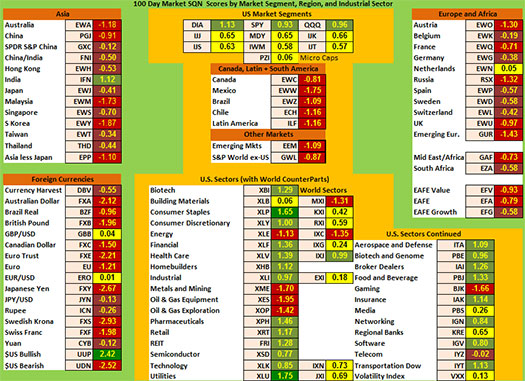
(Click here to see a larger version of this chart.)
So let’s start with Asia. Basically every country, except India, is negative (being either red or brown). The red countries include Australia, China, Malaysia, and South Korea. In the Americas, all of the countries and the Latin America ETF are red - except the US. Wow.
In Europe, only one country is yellow (the Netherlands) and the rest are negative. The red areas include Austria, France, Russia, the UK, and Emerging Europe. Again, all I can say is wow.
In the US, however, there are still a number of market sectors that are green. These include Consumer Staples and Utilities where both are dark green. The light green includes Biotech, Consumer Discretionary, Financial, Health Care, Homebuilders, Industrial, Pharmaceuticals, Retail, REITs, Semiconductors, Technology, Aerospace, Biotech and Genome, Broker Dealers, Food and Beverage, Insurance, Networking, Software, and Transportation.
The brown areas among the US sectors include Energy, Metals and Mining, Oil and Gas Equipment and Exploration.
The currencies are still dominated by the US dollar with the UK and the Euro being slightly yellow. However, please notice that most currencies are RED.
Commodities, Real Estate, Debt, Top and Bottom Lists
The next chart shows real estate, debt instruments, commodities and the top and bottom ETFs for the past 100 days.
This month, everything in commodities is red except for Global Water, Timber, Livestock, and Global Agriculture which are all yellow. It’s a very strong deflationary picture.
US real estate is strong but every other measure of real estate is weak (being brown).
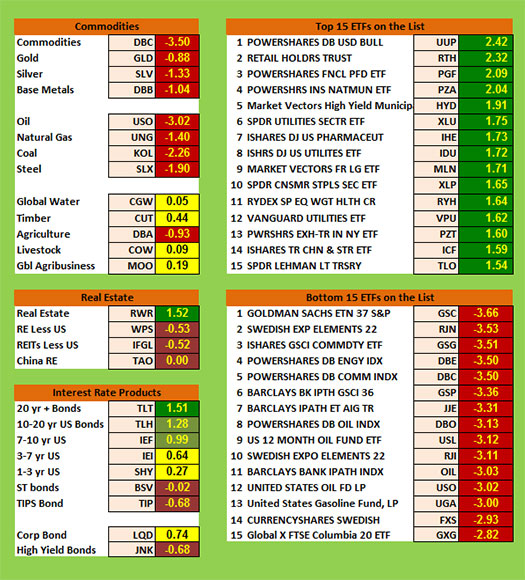
Finally in the debt instruments, US Treasuries (despite the low interest rates) are green. These include US bonds with a maturity of 7 years or longer. Medium term bonds are yellow and short term bonds, inflation protected bonds, and junk bonds are all brown. Corporate bonds are yellow.
We print the 15 top ranking ETFs list from the database and usually, the total number of ETFs with a high Market SQN score (dark green) goes on quite a bit longer. Currently, however, only 18 ETFs in the database are dark green - that didn’t happen even in 2008. Of those 18 dark green ETFs, only four have a Market SQN score above 2.0 and they include the US Dollar, Retail, Financial, and one Muni issue. That’s pretty dismal.
When I look at the weak ETFs, 31% of the ETFs we track are red or about 10 times as many as are dark green. Furthermore, we have 13 ETFs with scores below minus 3.0 - and that might be a new record since I’ve been keeping track.
Summary
Now let’s look at our newest table which measures the percentage of ETFs in each of the strength categories.
Date |
Very Bullish |
Bullish |
Neutral |
Bearish |
Very Bearish |
2013 |
> 1.5 |
0.75 - 1.5 |
0 - 0.75 |
0 - -0.7 |
< - 0.7 |
Jan 31st |
27.1% |
39.6% |
20.7% |
6.4% |
4.7% |
Feb 28th |
10.3% |
45.2% |
24.4% |
11.9% |
7.5% |
Mar 31st |
39.2% |
25.5% |
19.1% |
9.0% |
6.4% |
Apr 30th |
49.1% |
21.1% |
14.8% |
8.0% |
6.2% |
May 31st |
29,2% |
23.6% |
19.9% |
12.3% |
14.2% |
Jun 30th |
2.1% |
31.0% |
23.2% |
22.0% |
20.9% |
Jul 31st |
8.2% |
33.5% |
29.0% |
13.3% |
15.2% |
Aug 30th |
1% |
15% |
46.4% |
19.3% |
17.5% |
Sep 30th |
1% |
13.8% |
42.3% |
23.0% |
19.1% |
Nov 1st |
13.3% |
48.3% |
21.8% |
12.5% |
3.3% |
Dec 1st |
14.6% |
42.7% |
24.2% |
13.3% |
4.3% |
Dec 31st |
19.3.% |
45.5% |
22.0% |
11.3% |
2.9% |
2014 |
Jan 31st |
8.0% |
49.3% |
20.7% |
12.7% |
7.6% |
Feb 28th |
18.9% |
48.4% |
18.1% |
6.2% |
6.8% |
Mar 31st |
4.9% |
40.2% |
38.8% |
13.3% |
3.1% |
Apr 30th |
11.1% |
33.9% |
40.2% |
11.3% |
1.8% |
May 31st |
12.5% |
46.5% |
27.7% |
7.6% |
6.0% |
Jun 30th |
53.4% |
33.7% |
14.2% |
2.5% |
0.8% |
Aug 29th |
20.3% |
45.2% |
22.8% |
10.5% |
5.3% |
Sep 30th |
6.6% |
26.9% |
30.2% |
24.0% |
18.5% |
Oct 31st |
2.9% |
17.9% |
38.8% |
17.7% |
26.3% |
Nov 30th |
3.1% |
25.7% |
25.1% |
22.8% |
27.9% |
Dec 31st |
3.7% |
29.2% |
24.8% |
15.6% |
31.2% |
By the end October 44% of the ETFs had become bearish, at the end of November it was 50.7%, and this month it’s 46.8%. At 31.2% ranking very bearish, it is the lowest we have had in the last two years since I’ve been keeping track of this statistic.
I also keep track of the 100 day Market SQN scores for all of the stocks in the S&P 500. As of a few days ago, on January 3rd, the following was true of the S&P 500 stocks, 78.44% had positive Market SQN scores with 6.2% having scores over 2.0. Of the 500 S&P stocks, 21.55% had negative SQN 100 scores with 0.57% having scores below minus 2.0
Month |
Above 2.0 |
Positive |
Negative |
Below -2.0 |
Dec 31 2014 |
6.2% |
78.4% |
21.55% |
0.57% |
The economic fundamentals are still terrible for the US and the rest of the world. The US stock market and the US dollar are the long top performers in the world. While the December market update was somewhat positive with the overall market being slightly bullish. The SQN® Report really tells us what is going on and the global picture is dismal.
BE VERY CAREFUL IN THIS MARKET. Base your actions upon what is happening, not what you think might happen.
Until the end of January, this is Van Tharp.
The markets always offer opportunities, but to capture those opportunities, you MUST know what you are doing. If you want to trade these markets, you need to approach them as a trader, not a long-term investor. We’d like to help you learn how to trade professionally because trying to navigate the markets without an education is hazardous to your wealth.
All the beliefs given in this update are my own. Though I find them useful, you may not. You can only trade your own beliefs about the markets.
 Enter the Matrix Contest Enter the Matrix Contest
for a chance to win a free workshop!
We want to hear about the one most profound insight that you got from reading Van's new book, Trading Beyond the Matrix, and how it has impacted your life. If you would like to enter, send an email to [email protected].
If you haven't purchased Trading Beyond the Matrix yet, click here.
For more information about the contest, click here.
Ask Van...
Everything we do here at the Van Tharp Institute is focused on helping you improve as a trader and investor. Consequently, we love to get your feedback, both positive and negative!
Send comments or ask Van a question by clicking here.
Also, Click here to take our quick, 6-question survey.
Back to Top
Contact Us
Email us at [email protected]
The Van Tharp Institute does not support spamming in any way, shape or form. This is a subscription based newsletter.
To change your e-mail Address, e-mail us at [email protected].
To stop your subscription, click on the "unsubscribe" link at the bottom left-hand corner of this email.
How are we doing? Give us your feedback! Click here to take our quick survey.
Call us at: 800-385-4486 * 919-466-0043 * Fax 919-466-0408
SQN® and the System Quality Number® are registered trademarks of the Van Tharp Institute and the International Institute of Trading Mastery, Inc.
Be sure to check us out on Facebook and Twitter!
 
Back to Top |